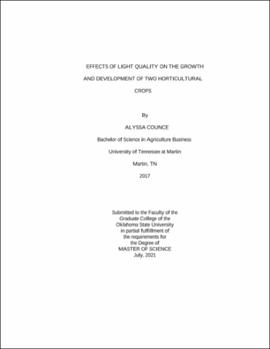| dc.contributor.advisor | Fontanier, Charles | |
| dc.contributor.author | Counce, Alyssa | |
| dc.date.accessioned | 2022-01-21T19:33:39Z | |
| dc.date.available | 2022-01-21T19:33:39Z | |
| dc.date.issued | 2021-07 | |
| dc.identifier.uri | https://hdl.handle.net/11244/333791 | |
| dc.description.abstract | The effect of various light environments on the growth of two horticultural crops was investigated. The growth and development of plants is affected by light quality, light periodicity, light quantity, and phototropism. These parameters can be controlled by photoselective filters or shade nets to induce morphological and physiological responses in plants. Two sets of greenhouse experiments were conducted by selectively screening sunlight for two horticultural crops, turfgrass and romaine lettuce (Lactuca sativa L. var. longifolia). Treatments for the turfgrass study included a blue polyester gel filter, 40% black poly-woven fabric, and a combination thereof to create reduced R:FR, reduced PPF, and reduced R:FR plus reduced PPF conditions to reproduce vegetative and neutral shade and observe shade avoidance responses under each treatment. Each shade treatment resulted in longer leaves, symptomatic of shade avoidance responses for both turfgrass species. Bermudagrass (Cynodon dactylon (L.) Pers. 'JSC2009-6') had a strong response to each shade treatment and exhibited a decrease in tillers and leaf count. However, there is little evidence that the reduced R:FR ratio in this study initiated responses in bermudagrass over responses to a reduced PPF. Treatments for the lettuce study included four commercial shade nets: Chromatinet pearl, Chromatinet red, aluminet, and standard black. Applied shade nets (all rated to decrease solar radiation by 30%) significantly reduced PPF from 1033 umol m^-2 s^-1 under ambient light to 617 - 733 umol m^-2 s^-1 under nets. Lettuce grown under pearl-+ shade net had the highest number of leaves. Lettuce grown under aluminet in the summer produced plants with a greater leaf area. Lettuce grown under red shade net had the greatest total dry weight. The results of both studies indicates that managing light quality with photoselective filters and spectrally modified shade nets does impact the growth and development of turfgrass and romaine lettuce. | |
| dc.format | application/pdf | |
| dc.language | en_US | |
| dc.rights | Copyright is held by the author who has granted the Oklahoma State University Library the non-exclusive right to share this material in its institutional repository. Contact Digital Library Services at lib-dls@okstate.edu or 405-744-9161 for the permission policy on the use, reproduction or distribution of this material. | |
| dc.title | Effects of light quality on the growth and development of two horticultural crops | |
| dc.contributor.committeeMember | Dunn, Bruce | |
| dc.contributor.committeeMember | Cartmell, Dwayne | |
| osu.filename | Counce_okstate_0664M_17328.pdf | |
| osu.accesstype | Open Access | |
| dc.type.genre | Thesis | |
| dc.type.material | Text | |
| dc.subject.keywords | hydroponics | |
| dc.subject.keywords | lettuce | |
| dc.subject.keywords | light quality | |
| dc.subject.keywords | photoselective nets | |
| dc.subject.keywords | r:fr ratio | |
| dc.subject.keywords | turfgrass | |
| thesis.degree.discipline | International Agriculture | |
| thesis.degree.grantor | Oklahoma State University | |
